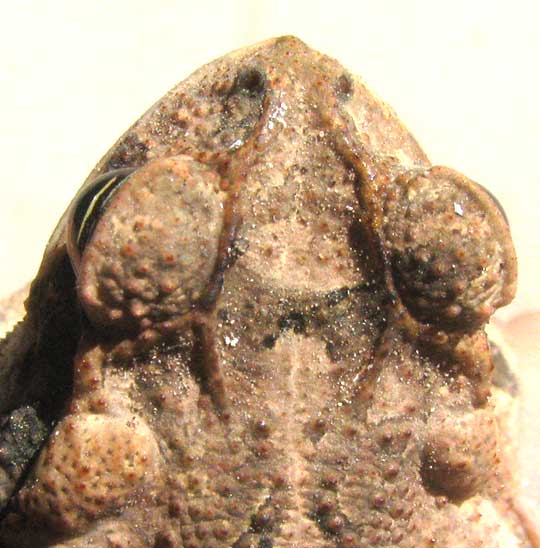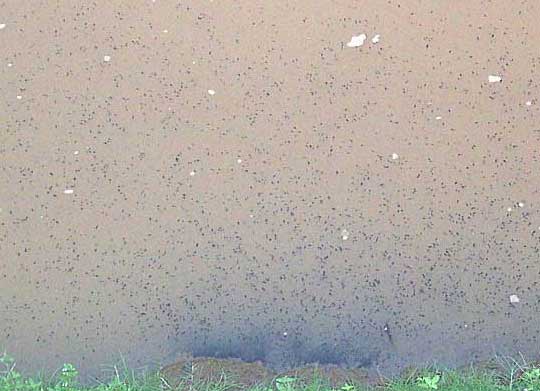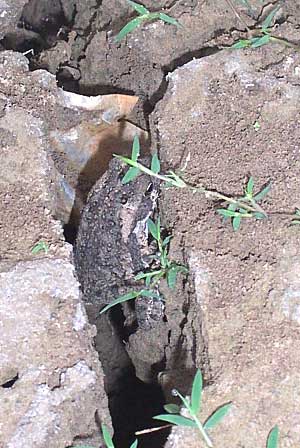Excerpts from Jim Conrad's
Naturalist Newsletter

from the September 16, 2012 Newsletter issued from the valley of the Dry Frio River in northern Uvalde County, southwestern Texas, on the southern border of the Edwards Plateau; elevation ~1750m (~5750 ft); N29.62°, W99.86°; USA
GULF COAST/ COASTAL PLAIN TOAD
This week while I was painting an outbuilding a toad hopped into my life. You can see what he looked like on our community park shelter's cement floor above.
Just last month when we looked at an American Toad in Mississippi we saw that for identification purposes a toad's "cranial crest" configuration atop its head is very important. Therefore, this week I was sure to photograph my visitor's crests, as shown at http://www.backyardnature.net/n/12/120916gd.jpg.
The cranial crests are the narrow ridges looking like slender wires inserted just below the skin originating near the nose tip then passing just behind the eyes, and forking. You might find it interesting to compare this configuration with that of last month's American Toad's below:

Notice how our visitor's cranial crests extend much closer to the nose tip than the American's, and that the shorter arm of the fork behind the eye is much longer than the American's short arm. Also our toad's parotoid glands -- the big bumps below the crests -- are smaller than the American's, and vaguely triangular instead of bean-shaped.
This cranial crest and parotoid configuration is exactly that of the Gulf Coast Toads we've met several times in Mexico. Moreover, my old US field guides leave no doubt that what we have here is exactly the Gulf Coast Toad.
However... Since my field guides' publications those pesky gene sequencers who can determine an organism's true identity by looking at its DNA have determined that US toads with cranial crests like ours are a different species from the Gulf Coast Toad, which is strictly Mexican and Central American. Our toads with such cranial crests are to be known scientifically as BUFO NEBULIFER*, and some experts are trying to establish the English name for that species as Coastal Plain Toad.
So, the same US frogs that before the gene sequencing paper was published in 2000 were known as Gulf Coast Toads, Bufo valliceps, now are called Coastal Plain Toads, Bufo nebulifer.
Our Coastal Plain Toads, by the way, also extend deep into Mexico. The ones we saw in Querétaro were apparently Gulf Coast Toads.
So, that's how it goes. Spend a whole life calling something by a name, then somebody comes out with an obscure paper and you have to begin calling it something else.
from the July 28, 2013 Newsletter issued from the Frio Canyon Nature Education Center in the valley of the Dry Frio River in northern Uvalde County, southwestern Texas, on the southern border of the Edwards Plateau; elevation ~1750m (~5750 ft); N29.62°, W99.86°; USA
A NEWLY METAMORPHOSED TOAD
As I walked along the edge of a small pool in the mostly dry Dry Frio River, many dark, thumbnail-sized frogs jumped out of my way. One of them, instead of escaping into the water, hopped inland and took up position between two limestone cobbles as shown below:

I wasn't sure what species he was. My approach to identifying reptile and amphibian species is to visit the Herps of Texas website ("herps" refers to reptiles and amphibians grouped together) where all of Texas's herps are represented. You may enjoy reviewing the Frogs & Toads Page of the "Herps of Texas".
Using this approach I came upon the narrowly endemic Cliff Chirping Frog, found only in a few counties here in southwestern and central Texas. It's exceptionally small, like our subject in the picture, and when it escapes it finds a crevice in limestone rock into which to wedge itself, much like our frog sought to settle between two rocks. Also the heads of Cliff Chirping Frogs are unusually broad, like the head of ours. However, our frog was darker and the skin was rougher than on Cliff Chirping Frogs illustrated on the Internet, so I just wasn't sure.
On the Internet there's a very active Field Herp Forum attended by many serious herpers, at http://www.fieldherpforum.com/forum/.
I have an account there so I uploaded our picture and asked other herpers if they thought it was a Cliff Chirping Frog.
Within five minutes someone replied that it was a recently metamorphosed toad, not a Cliff Chirping Frog. Before long two others agreed. Our frog's skin is too rough and, as one herper said, "it just doesn't have the right gestalt," -- too stocky.
Well, we have several toad species here but, based on the fact that most toads I see are Coastal Plain Toads, and that that species displays bars on the hind legs like the tiny individual in my picture, I'm supposing that our picture shows a very young Coastal Plain Toad. In fact, maybe that bump at his lower back is what's left of his tail.
So, this is a very commonplace find, but it's worth relating the story to show that even commonly encountered organisms can challenge us, and that in figuring things out, you learn a lot, and have some fun.
from the May 26, 2007 Newsletter issued from Sierra Gorda Biosphere Reserve, QUERÉTARO, MÉXICO
MILLIONS OF TADPOLES & TOADS
Up where the reservoir narrows between steep slopes and wet-season shallows now stand as Frogfruit-mantled terraces, you wouldn't believe the numbers of tadpoles. Well, you can get an idea from the picture below:

That image shows thousands of pea-sized tadpoles alongshore, and similar tadpole superfluity continued up and down the bank a long way. How on Earth could there be enough food for them to eat? I assumed the water was muddy because the previous afternoon cattle had been wading in it to keep cool, but maybe it was just kept churned up by tadpoles.
 And maybe the overabundance of tadpoles explains the hoards of tiny toads swarming through the vegetation mantling the former mudflats, where there's a toad about every half foot. Most toads are pea-sized but some are half grown and at least two looked like adults. One adult jumped from my path leaving a silvery jet of pee in his wake and the other remained cozily in a big mud crack as I took the picture shown at the right.
And maybe the overabundance of tadpoles explains the hoards of tiny toads swarming through the vegetation mantling the former mudflats, where there's a toad about every half foot. Most toads are pea-sized but some are half grown and at least two looked like adults. One adult jumped from my path leaving a silvery jet of pee in his wake and the other remained cozily in a big mud crack as I took the picture shown at the right.
The toad in the mud crack seems to be the Gulf Coast Toad, BUFO NEBULIFER, distributed from the US Gulf Coast south to about here. I can't be certain that the tadpoles and immature toads are the same species, but it's a good bet.
In fact, when I camped out last Saturday night near where the above photos were taken I was awakened in the night twice by sounds. First, a little shower came very pleasantly pecking on my tent roof around midnight and, second, not long afterwards, a placidly thunderous chorus of multitudinous toad-calls awoke me.